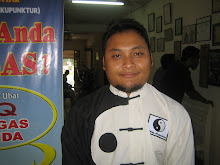Thursday, January 14, 2010
How Acupuncture Works.....
What will happen on my first visit?
Your first consultation may be longer than subsequent sessions. The acupuncturist needs to assess your general state of health in order to identify the underlying patterns of disharmony and give you the most effective treatment.
You will be asked about your current symptoms and what treatment you have received so far, your medical history and that of your close family, your diet, digestive system, sleeping patterns and emotional state. Once enough information has been gathered to determine the likely causes of your problems, the acupuncturist can select the most appropriate treatment.
To discover how the energies are flowing in your body, the acupuncturist is likely to feel your pulses on both wrists, noting their quality, rhythm and strength. The structure, colour and coating of your tongue also give a good guide to your physical health. The aim is to discover which energy channels need adjusting for your specific complaint to improve, and which require treatment to boost your overall energy and vitality.
Stimulating specific acupuncture points may affect the functioning of certain organs in the body. However, those points may not be close to the part of the body where the problem is experienced. For example, although you may suffer from headaches, needles may be inserted in your foot or hand. There are around 500 such acupuncture points on the body. A properly trained and experienced acupuncturist will use a selection of perhaps ten or twelve of these for each treatment. It is quite usual for different points to be selected as the patient's condition changes during a course of treatment. photo of shoulder acupuncture
The acupuncturist may supplement needle treatment with moxa, a smouldering herb which is used to warm acupuncture points and encourage the body's energy to flow smoothly. Other methods of stimulating acupuncture points include the use of lasers or electro-acupuncture. Massage or tapping with a rounded probe are techniques particularly suitable for small children or for people with a fear of needles.
It is helpful to wear loose, comfortable clothing for your treatment and you should be aware that your acupuncturist may need access to points on your torso as well as on your arms and legs.
What does it feel like?
Acupuncture needles bear little resemblance to the needles used in injections and blood tests. They are much finer and solid, not hollow. When a needle is inserted, the sensation is often described as a tingling or dull ache. Needles may be inserted and immediately removed, or may be left in place for thirty minutes or more, depending on the effect required. During treatment, patients commonly experience a heaviness in the limbs or a pleasant feeling of relaxation. The benefits of acupuncture frequently include more than just relief from a particular condition. Many people find that it can also lead to increased energy levels, as well as better appetite and sleep, and an enhanced sense of overall wellbeing.
Your first consultation may be longer than subsequent sessions. The acupuncturist needs to assess your general state of health in order to identify the underlying patterns of disharmony and give you the most effective treatment.
You will be asked about your current symptoms and what treatment you have received so far, your medical history and that of your close family, your diet, digestive system, sleeping patterns and emotional state. Once enough information has been gathered to determine the likely causes of your problems, the acupuncturist can select the most appropriate treatment.
To discover how the energies are flowing in your body, the acupuncturist is likely to feel your pulses on both wrists, noting their quality, rhythm and strength. The structure, colour and coating of your tongue also give a good guide to your physical health. The aim is to discover which energy channels need adjusting for your specific complaint to improve, and which require treatment to boost your overall energy and vitality.
Stimulating specific acupuncture points may affect the functioning of certain organs in the body. However, those points may not be close to the part of the body where the problem is experienced. For example, although you may suffer from headaches, needles may be inserted in your foot or hand. There are around 500 such acupuncture points on the body. A properly trained and experienced acupuncturist will use a selection of perhaps ten or twelve of these for each treatment. It is quite usual for different points to be selected as the patient's condition changes during a course of treatment. photo of shoulder acupuncture
The acupuncturist may supplement needle treatment with moxa, a smouldering herb which is used to warm acupuncture points and encourage the body's energy to flow smoothly. Other methods of stimulating acupuncture points include the use of lasers or electro-acupuncture. Massage or tapping with a rounded probe are techniques particularly suitable for small children or for people with a fear of needles.
It is helpful to wear loose, comfortable clothing for your treatment and you should be aware that your acupuncturist may need access to points on your torso as well as on your arms and legs.
What does it feel like?
Acupuncture needles bear little resemblance to the needles used in injections and blood tests. They are much finer and solid, not hollow. When a needle is inserted, the sensation is often described as a tingling or dull ache. Needles may be inserted and immediately removed, or may be left in place for thirty minutes or more, depending on the effect required. During treatment, patients commonly experience a heaviness in the limbs or a pleasant feeling of relaxation. The benefits of acupuncture frequently include more than just relief from a particular condition. Many people find that it can also lead to increased energy levels, as well as better appetite and sleep, and an enhanced sense of overall wellbeing.
Subscribe to:
Post Comments (Atom)





No comments:
Post a Comment